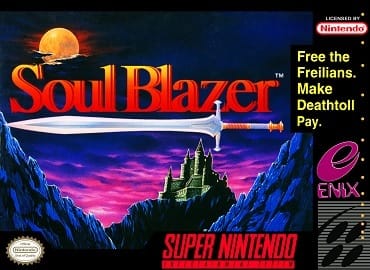- Blow On The Cartridge
- Posts
- Soul Blazer
Soul Blazer
Saving humanity? There’s a lair for that.


Soul Blazer: Because property damage is fine as long as it brings a village back.

A few articles ago, we explored ActRaiser, a hybrid side scrolling/city builder classic from the early line up of the SNES. We now turn our attention to another Quintet title: Soul Blazer, released two years later.
Widely regarded by fans and journalists as the first installment in the unofficial “Quintet Trilogy” (aka the “Gaia Trilogy”), Soul Blazer shares its legacy with two other iconic SNES titles, Illusion of Gaia and Terranigma. These games are deeply connected, sharing thematic and mechanical DNA.
While not officially a prequel, Soul Blazer feels spiritually linked to ActRaiser. It explores similar godlike themes of restoration, but from a ground-level action rpg perspective.
What immediately drew me when I first played it back in the 90’s, wasn’t the dungeon crawling or the combat, but the soul retrieval mechanic. Much like ActRaiser's civilization-building mode, every enemy spawn point you defeat in Soul Blazer returns life to the world. People, animals, even entire buildings appear from nothing.
Watching desolate towns gradually repopulate gave a profound sense of purpose. Your actions weren’t just about leveling up or grabbing loot, they were about rebuilding a world, one soul at a time.
Let’s dive into Soul Blazer.

Your job? Slay monsters, collect gems, and bring back the local bakery. In that order.

Soul Blazer throws you into the role of a divine servant sent by The Master to restore a world drained of life by the evil Deathtoll. I guess when his mom named him, she didn’t think he was going into accounting.
The premise is simple, King Magridd traded every living soul for gold, leaving behind a barren wasteland populated only by monsters. Your job is to fix his mess by clearing monster lairs and releasing the trapped souls within.
The gameplay loop follows a satisfying pattern. Enter a dungeon, destroy monster lairs scattered throughout, watch as each destroyed lair releases souls that repopulate the overworld. Your character can level up, equip new items, weapons and armor. Hidden items can be found throughout towns and dungeons.
Towns spring back to life gradually, people, animals, and even plants return to their rightful places, like a divine game of SimCity. What makes Soul Blazer special is how cleverly it links your dungeon-crawling to world restoration.
Early on, you’ll find a broken elevator deep in the first dungeon. Can’t fix it there. Instead, you have to free the water mill back in town, then help an NPC manually crank it to life which magically powers the elevator underground.
This mechanic transforms what could have been mindless dungeon crawling into something emotionally engaging as you slowly rebuild society and solve puzzles while exploring.

Turns out, saving the world involves a surprising amount of manual labor.
Combat feels straightforward but effective. You will feel comfortable with this if you’ve ever played A Link to the Past. Your sword slash has a generous hit box and you can easily dispatched enemies by coming at them from the right angle.
The magic system will take some getting used to. That little blue fireball constantly spinning around you in the screenshots? It’s not just for decoration.
When you attack, the fireball shoots off in whatever direction you’re facing but because it’s rotating, timing your shot can be frustrating. Especially when you're surrounded and it feels less like spellcasting and more like trying to pass a hot potato during a demon ambush.
There are other magic attacks you eventually unlock, but the magic system never felt comfortable to me.

I’ve got magic, but it's got commitment issues.
What sets Soul Blazer apart is how enemies stay dead after you eliminate their lairs, even if you die or restart the game after a break. This prevents the frustration of losing progress and maintains the narrative logic of permanently restoring life to the world.
Even when you die, and you will, it still feels like progress. The game also features an early fast travel system. Going back to it, I really felt this game respects your time.
Quintet's visual presentation showcases the SNES capabilities well, with colorful sprite work and smooth animations. It’s an early SNES title still, so don’t expect the game to push the system to its limits.
The soundtrack, composed by Yukihide Takekawa, complements the restoration theme perfectly, shifting from somber tunes in empty areas to uplifting melodies as life returns. Some tracks are not what you typically hear in a rpg. But that helps make it stand out and I enjoyed what I heard.
Sound effects punctuate each soul release with satisfying chimes that reinforce the positive impact of your actions.

In Soul Blazer, progress isn’t just level-ups, it’s people, homes, and hope returning to the world.
The six worlds offer varied environments, from grasslands to marshes, each with unique challenges and inhabitants to rescue.
Boss battles cap off each area with memorable encounters that test your skills. It had been years since I replayed this game before writing this article and completely forgot how to take down the first boss. I lasted a good 5 seconds the first time I faced him.
But learn the pattern, find the weak spot and you can beat these guys without losing any health. The pacing keeps you engaged throughout the roughly 10 to 15hour adventure.

Bringing back all the good boys and girls in Soul Blazer is peak game design. No notes.

Game Information
| Where to Play Today
|
 Cover Art: Coming this fall, Deathtoll Live at Red Rocks. Souls not included. | That bassline… love it. |

Info on 780 SNES games. Love this book and can’t recommend it enough! | Heat Changing. When cold, displays a plain Mario level background, when hot, background changes color and extra details appear. |
As an Amazon Associate, I earn from qualifying purchases at no extra cost to you. Clicking these links helps support the newsletter and keeps the pixels glowing. It’s very much appreciated and I thank you in advance!

Soul Blazer succeeds because it understands that players crave purpose beyond personal advancement. The act of rebuilding civilization creates an emotional investment that pure combat cannot match. When you rescue a soul, you're not just earning points, you're genuinely helping someone return home.
Looking back, the game's brevity becomes a strength rather than a weakness. There's no padding, no fetch quests, no artificial difficulty spikes. Every dungeon serves the story, every soul rescued matters to the world's recovery. This focused approach feels refreshing compared to modern games that often overstay their welcome.

Me: I’ve got full health.
Boss: That’s cute.
The restoration mechanic adds weight to your actions that most action RPGs lack. You're not conquering, you're healing. You're not claiming territory, you're giving it back to its rightful inhabitants. This distinction elevates Soul Blazer from a competent dungeon crawler to something more meaningful.
Soul Blazer may not reach the heights of A Link to the Past or Secret of Mana, but it carves out its own identity within the SNES library. It's a game that respects your time while delivering genuine emotional satisfaction. For anyone seeking a purposeful adventure with heart, Soul Blazer delivers exactly what it promises.

No dramatic music. No flashing GAME OVER. Just quiet divine disappointment.

The tots begin to shift.



Reply